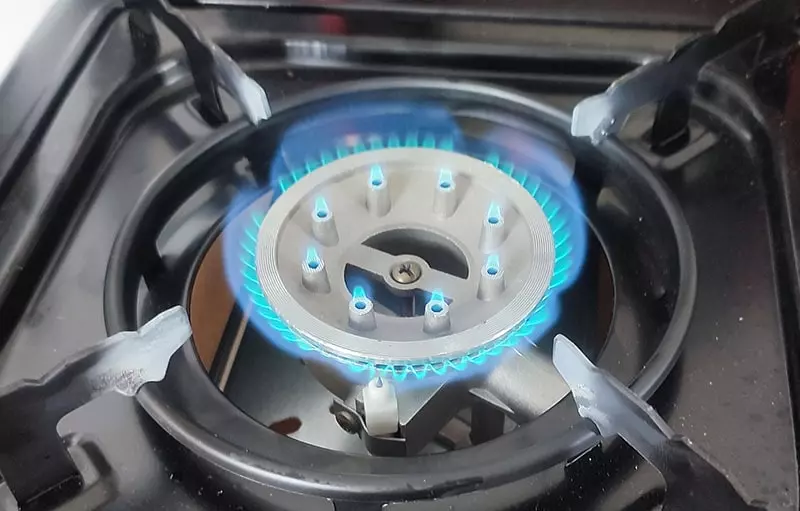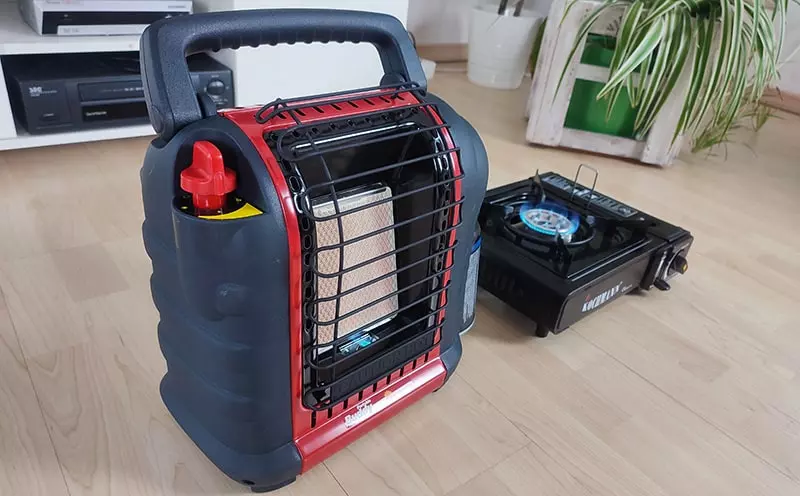Can you use a gas stove as a heater? Especially in emergencies, when there is no electricity and even central heating turns off, you need a backup heat source.
If you have a gas stove at home, then using it could be an option.
In this article, we’re going to check everything you need to know about emergency heating using your gas stove. And you’re going to learn about better (and more cost-efficient) alternatives to gas stoves.
Quick answer: Yes, you can use a gas stove as a heater. To do it safely, monitor the blue flame color (which indicates the presence of oxygen) and vent your room occasionally. For better heat distribution and flame coverage, place a water-filled pot on the stove. However, you should only use a gas stove as a heater in an absolute emergency. If you are not in an emergency situation right now, prepare and get a portable propane heater as a backup heat source.
Can you use a gas stove as a heater?
Theoretically, yes you can use a gas stove as a heater. A gas stove is technically very similar to a gas heater. The main difference is, however, the lack of safety mechanisms.
In the end, a gas stove does the very same thing as a gas heater. The gas flame in a gas stove only heats a pot or pan instead of your whole room under normal circumstances.
In an emergency, such as an electricity outage, you can, of course, turn on your gas heater. In emergency situations, the most important goal is to stay alive.
Then, it does not matter what people online say.
Here’s one example of people online panicking:
“No! Using a gas appliance improperly can cause it to take in too much oxygen from the air, leading to asphyxiation, or not enough oxygen, leading to carbon monoxide poisoning.”
The same website even claims that you can’t even use propane heaters indoors. Ridiculous.
As a heating-dedicated website, I can confidently say: That’s false!
You can safely burn propane indoors without raising carbon monoxide levels. All gases burn without carbon monoxide formation as long as there is enough oxygen in your room.
What really matters is that the propane flame burns blue. This is a sign that the combustion has enough oxygen. This, in turn, means, that no carbon monoxide is created.
If running a gas stove as an emergency heat source really is this dangerous, then why is is safe to cook?
Cooking soup can also take 1-2h. If you don’t vent the kitchen during cooking, then what makes the cooking safer than heating?
Right!
There is no difference.
Safety issues with using a gas stove as a heater (and how to fix them)
Using a gas stove in an emergency is not safe. In fact, there are several things that make using a gas stove as a heat source quite dangerous.
In this section, we will have a look at the most significant problems with using a gas stove as a heater. And, for each problem, I am going to tell you what you can do to solve it!
No oxygen depletion sensor
Most gas stoves don’t have a built-in oxygen depletion sensor. An oxygen depletion sensor is a sensor that notices when the gas combustion lacks oxygen.
Ideally, gas combustion should never lack oxygen. A lack of oxygen results in the formation of carbon monoxide and other toxic gases such as aldehydes.
Gas heaters, such as propane heaters, oftentimes have a built-in oxygen sensor that notices a lack of oxygen and, in turn, shuts off the heating.
Gas stoves usually don’t have these sensors and burn even if their oxygen intake is improperly adjusted.
This not only creates potentially toxic gases but also causes an inefficient burn. Gas burns most efficiently when the combustion process does not lack oxygen.
Solution:
You can’t really change the fact that your gas stove does not have an oxygen depletion sensor. But you can be your own oxygen depletion sensor!
There are two things you should constantly do:
- Monitor the gas flame color. It should always be blue. A flame color change to yellow indicates an issue with combustion. If your flame turns yellow, double-check that the gas stove is clean (since dirt can also cause yellow flames). Then, adjust the oxygen intake until the flame turns blue again.
- Regularly vent your room. Since improper combustion can form carbon monoxide, you should regularly vent your room.
As long as the flame burns blue, the risk of carbon monoxide poisoning is very small. Still, open your window regularly for a few minutes just to make sure. - Listen to your body. Lack of oxygen can cause headache (small lack) and nausea (significant lack). If you notice any health-related issues, turn off your gas stove.
 The flame of your gas stove always has to be blue!
The flame of your gas stove always has to be blue!
No tip-over protection
Most portable gas heaters have a built-in tip-over protection. Now, tipping over is not really an issue for a big kitchen stove.
But you have to be careful with portable gas stoves. These can easily fall off the table and cause a fire, as they don’t stop burning.
Solution:
Place your (portable) gas stove in a very safe place to minimize the likelihood of it dropping.
Also, place it out of reach for kids and pets.
Open flames
The open flames of a burning gas stove are probably the most dangerous aspect of running a gas stove as a heater.
Open flames ignite things easily.
Solution:
You can’t really avoid open flames in a burning gas stove. However, you can cover the flames.
To cover the flames, place a large metal pot filled with water on the stove. Put the lid on the pot and turn on the gas heater.
Now, the metal pot hides the flames. And additionally, it helps distribute the heat.
No heat distribution
Most gas heaters have a ceramic (or similar material) heating panel that the gas flame heats. This heating panel, in turn, starts glowing.
This, in turn, causes the heat to radiate into the room, instead of just rising straight up.
Gas stoves don’t have these built-in heating panels. Instead, they just emit flames that create hot air which rises to the ceiling.
Technically, heating panels don’t matter, because all heat will eventually distribute in your room.
However, the perceived heat of gas heaters is higher, because they radiate the heat into the room. So, you feel the heat directly radiating at you.
With a gas stove, you only get warm air, with poor heat distribution.
Solution:
As in the previous section, place a water-filled metal pot (with a lid on top), on your gas stove.
The pot absorbs the heat from the flames and distributes it over the large metal surface.
Theoretically, you can also place a pot without water on your gas stove. But depending on the pot material and surface finish, this might damage your pot.
I recommend filling it with water since it is a very good heat store.
 Portable propane gas heaters are a much safer backup heat source than gas stoves. Always have one around!
Portable propane gas heaters are a much safer backup heat source than gas stoves. Always have one around!
What’s a better alternative to using a gas stove as a heater?
You should only use your gas stove as a heater in an absolute emergency.
Gas heaters are very unsafe. Even though I listed a few solutions for the most common safety issues in this post, your stove can still be dangerous.
The uncalculated dangers (that we both probably don’t even think about) are much greater in a gas stove than in a portable gas heater that has been around and tested for decades.
That’s why I always recommend using a portable propane heater as a backup heat source.
Propane heaters can output the same amount of heat as your gas stove.
But they are a lot safer.
My personal favorite is the Mr. Heater Buddy (click here to view it on amazon). It has all the safety features you need. Including a built-in tip-over protection, an oxygen depletion sensor, and an auto-shutoff in case of overheating or an issue with the gas supply.
Using this gas hose (click here to view it on amazon), you can even connect it to your gas stove’s gas tank.
So, in an emergency, you can just hook up the propane heater and you are ready & safe to go.
If you are not in an emergency right now, but you are preparing, then the Mr. Heater Buddy is a must-get.
Conclusion
You can use a gas stove for emergency heating if you are in an emergency right now. However, for emergency preparation, get a portable propane heater.
A portable propane heater is very affordable ($100 to $200 depending on the model). And it ensures that you are safe and warm throughout any energy outage.
Imagine having an energy outage, and on top of that you blow your house up because you decided to use a gas stove as a heater.
That would be a stupid story to tell your grandchildren.
So, better prepare well!
